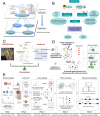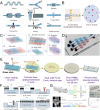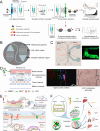Lab-on-a-chip: an advanced technology for the modernization of traditional Chinese medicine
- PMID: 38853247
- PMCID: PMC11163804
- DOI: 10.1186/s13020-024-00956-4
Lab-on-a-chip: an advanced technology for the modernization of traditional Chinese medicine
Abstract
Benefiting from the complex system composed of various constituents, medicament portions, species, and places of origin, traditional Chinese medicine (TCM) possesses numerous customizable and adaptable efficacies in clinical practice guided by its theories. However, these unique features are also present challenges in areas such as quality control, screening active ingredients, studying cell and organ pharmacology, and characterizing the compatibility between different Chinese medicines. Drawing inspiration from the holistic concept, an integrated strategy and pattern more aligned with TCM research emerges, necessitating the integration of novel technology into TCM modernization. The microfluidic chip serves as a powerful platform for integrating technologies in chemistry, biology, and biophysics. Microfluidics has given rise to innovative patterns like lab-on-a-chip and organoids-on-a-chip, effectively challenging the conventional research paradigms of TCM. This review provides a systematic summary of the nature and advanced utilization of microfluidic chips in TCM, focusing on quality control, active ingredient screening/separation, pharmaceutical analysis, and pharmacological/toxicological assays. Drawing on these remarkable references, the challenges, opportunities, and future trends of microfluidic chips in TCM are also comprehensively discussed, providing valuable insights into the development of TCM.
Keywords: Active ingredient screening; Compatibility of traditional Chinese medicine; Microfluidic chip; Pharm-lab-on-a-chip; Quality control; Traditional Chinese medicine.
© 2024. The Author(s).
Conflict of interest statement
The authors declare no competing interests.
Figures







Similar articles
-
Exploration of compatibility rules and discovery of active ingredients in TCM formulas by network pharmacology.Chin Herb Med. 2024 Apr 2;16(4):572-588. doi: 10.1016/j.chmed.2023.09.008. eCollection 2024 Oct. Chin Herb Med. 2024. PMID: 39606260 Free PMC article. Review.
-
Recent progress of microfluidic technology for pharmaceutical analysis.J Pharm Biomed Anal. 2022 Feb 5;209:114534. doi: 10.1016/j.jpba.2021.114534. Epub 2021 Dec 11. J Pharm Biomed Anal. 2022. PMID: 34929566 Review.
-
[Applications of chromatography in giant complex drug-organism system].Se Pu. 2021 Sep;39(9):950-957. doi: 10.3724/SP.J.1123.2021.06021. Se Pu. 2021. PMID: 34486834 Free PMC article. Review. Chinese.
-
Chinese medicine and its modernization demands.Arch Med Res. 2008 Feb;39(2):246-51. doi: 10.1016/j.arcmed.2007.09.011. Epub 2007 Nov 26. Arch Med Res. 2008. PMID: 18164973 Review.
-
[Application of network pharmacology and high through-put technology on active compounds screening from traditional Chinese medicine].Zhongguo Zhong Yao Za Zhi. 2012 Jan;37(2):134-7. Zhongguo Zhong Yao Za Zhi. 2012. PMID: 22737838 Chinese.
Cited by
-
Micro- and Nanoengineered Devices for Rapid Chemotaxonomic Profiling of Medicinal Plants.Nanomaterials (Basel). 2025 Jun 10;15(12):899. doi: 10.3390/nano15120899. Nanomaterials (Basel). 2025. PMID: 40559262 Free PMC article. Review.
-
Construction and Application of Traditional Chinese Medicine Knowledge Graph Based on Large Language Model.Interdiscip Sci. 2025 Jul 2. doi: 10.1007/s12539-025-00735-1. Online ahead of print. Interdiscip Sci. 2025. PMID: 40603824
-
Organoid, organ-on-a-chip and traditional Chinese medicine.Chin Med. 2025 Feb 12;20(1):22. doi: 10.1186/s13020-025-01071-8. Chin Med. 2025. PMID: 39940016 Free PMC article. Review.
References
-
- Luo G, Liang Q, Wang Y. Fingerprinting of Chinese materia medica: quality evaluation. Ltd: Quality Control and New Drug Development. Chemical Industry Press Co.; 2009. pp. 1–20.
-
- Luo G, Wang Y, Liang Q, Liu Q. Systems biology for traditional Chinese medicine. Hoboken: Wiley; 2012. pp. 1–33.
-
- Li S. Network pharmacology evaluation method guidance - draft. World J Tradit Chin Med. 2021;7(1):146–154. doi: 10.4103/wjtcm.wjtcm_11_21. - DOI
Publication types
Grants and funding
LinkOut - more resources
Full Text Sources
Miscellaneous

